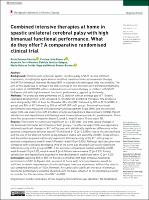Por favor, use este identificador para citar o enlazar este ítem:
https://repositorio.usj.es/handle/123456789/633
| Título : | Combined intensive therapies at home in spastic unilateral cerebral palsy with high bimanual functional performance. What do they offer? A comparative randomised clinical trial |
| Autor: | Palomo-Carrión, Rocío


Lirio-Romero, Cristina 

Ferri-Morales, Asunción 

Jovellar-Isiegas, Patricia 


Cortés-Vega, María-Dolores 

Romay Barrero, Helena María 

|
| Palabras clave : | Family; Home; Intensive therapies; Upper extremity; Unilateral spastic cerebral palsy |
| Fecha de publicación: | 12-ago-2021 |
| Editorial : | SAGE PUBLICATIONS LTD |
| Citación : | Palomo-Carrión R, Lirio-Romero C, Ferri-Morales A, Jovellar-Isiegas P, Cortés-Vega M-D, Romay-Barrero H. Combined intensive therapies at home in spastic unilateral cerebral palsy with high bimanual functional performance. What do they offer? A comparative randomised clinical trial. Therapeutic Advances in Chronic Disease. January 2021. doi:10.1177/20406223211034996 |
| Resumen : | Background: Children with unilateral spastic cerebral palsy (USCP) receive different treatments, including the application of modified constraint induced movement therapy (mCIMT) or bimanual intensive therapy (BIT) to increase affected upper limb functionality. The aim of this study was to compare the effectiveness of two protocols with different proportions and orders of mCIMT/BIT within combined intensive home-therapy in children with USCP (6-8 years old) with high bimanual functional performance, applied by the family. Methods: The protocols were performed on 20 children with an average age of 7.12 years [standard deviation (SD): 0.70], allocated to two different combined therapies. The protocols were designed by 100 h of dose for 10 weeks: 80 h of mCIMT followed by 20 h of BIT (mCIMT-B group) and 80 h of BIT followed by 20 h of mCIMT (BIT-mCI group). Bimanual functional performance was measured with Assisting Hand Assessment Scale (AHA) and the affected upper limb-use experience with Children's Hand-use Experience Questionnaire (CHEQ). Parent satisfaction and expectations with therapy were measured using a specific questionnaire. There were five assessment timepoints (week 0, week 4, week 8, week 10 and week 34). Results: There were no statistically significant (p > 0.05) inter- and intra-group changes in the bimanual functional performance of both groups. The affected upper limb-use experience obtained significant changes in BIT-mCI group, with statistically significant differences in the pairwise comparisons between week 0-10 and week 4-10 (p = 0.028) for use of the affected hand and the use of the affected hand to grasp between week 4 and week 8 (p = 0.028). Grasp efficacy and discomfort acquired statistically significant differences only in the BIT-mCI group for pairwise comparisons week 0-week 10/week 4-week 10 (p = 0.035). Although task execution time compared with a typically developing child of the same age obtained statistically significant differences only in the group mCIMT-B for pairwise comparisons week 0-week 8 (p = 0.03), week 0-week 10 (p = 0.03), week 4-week 8 (p = 0.04) and week 4-week 10 (p = 0.03). Family satisfaction and expectations acquired an increase between week 0 and week 10 (p <= 0.02). Conclusion: Applying 80 h of BIT for 8 weeks in children with high bimanual functional performance USCP (6-8 years old), executed at home with family involvement would be sufficient to obtain improvements in affected upper limb-use experience, without the need to use combined protocols of 100 h. However, no statistically significant increase in bimanual functional performance would be obtained, with the basal situation of the child being a factor to consider for the execution of mCIMT and BIT. |
| URI : | https://repositorio.usj.es/handle/123456789/633 |
| ISSN : | 2040-6231 |
| Aparece en las colecciones: | Artículos de revistas |
Ficheros en este ítem:
| Fichero | Descripción | Tamaño | Formato | |
|---|---|---|---|---|
| Combined intensive therapies at home in spastic unilateral cerebral palsy with high bimanual functional performance. What do they offer A comparative randomised clinical trial.pdf | 619,46 kB | Adobe PDF |  Visualizar/Abrir |
Este ítem está sujeto a una licencia Creative Commons Licencia Creative Commons

